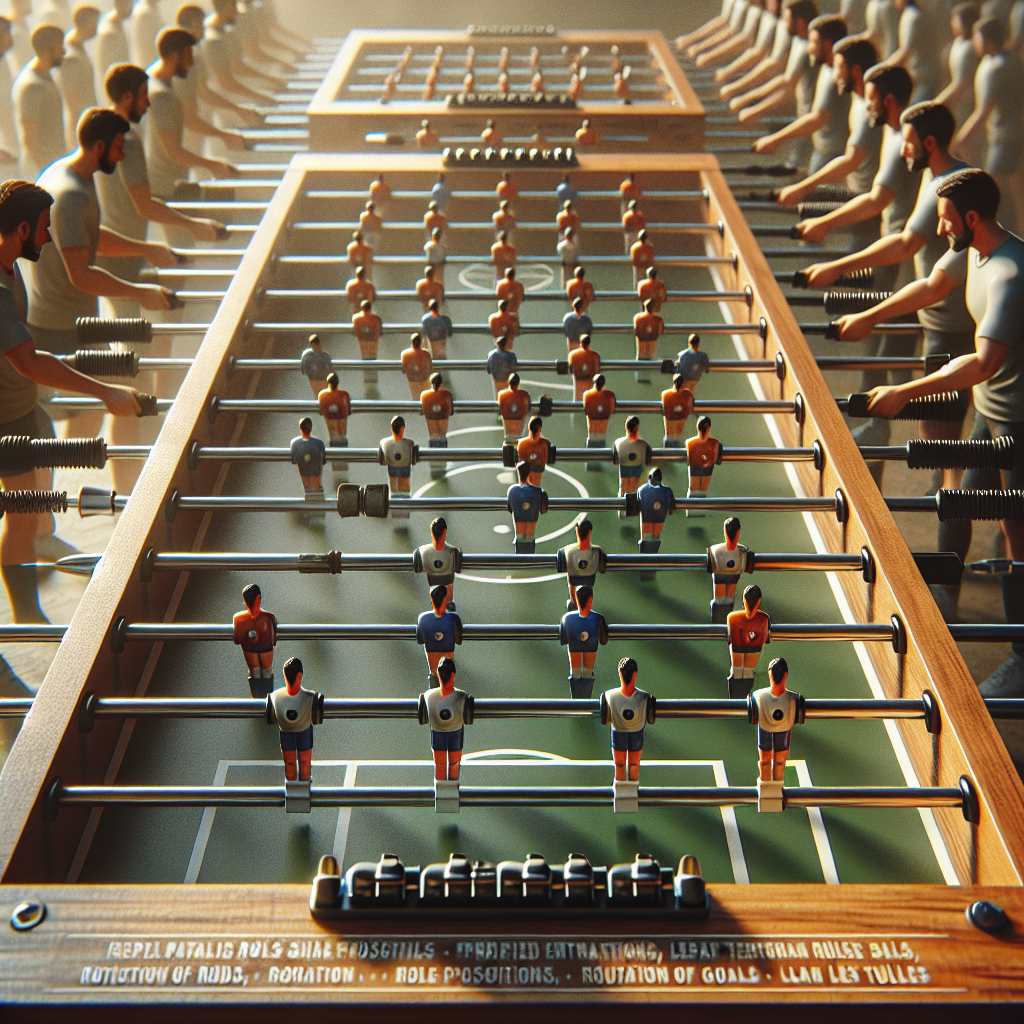Getting the Hang of Foosball Rules
If you want to crush it at foosball, you gotta know the official rules. Let’s break down the basics and some key rules that keep the game fair and fun.
The Basics
Foosball is like soccer on a table, with two teams trying to score goals. The game happens on a foosball table with tiny players on rods that you twist and turn.
Your goal? Get that ball into your opponent’s goal while blocking them from scoring on you. The team with the most goals after a set number of rounds or the first to hit a certain goal count wins.
Fair play is a big deal in foosball. Follow the rules, play nice, and don’t be a jerk. Cheating or trying to mess with your opponent is a no-go.
Key Rules
Here are some must-know rules to keep the game smooth and fair:
-
No Crazy Spinning: Spinning the rods all the way around (360 degrees) is a no-no. You need to make controlled moves without going wild with the spinning. This keeps the game skillful and strategic, not just about brute force.
-
No Table Bumping: Jarring, or hitting and pushing the table to mess with your opponent, is off-limits. It messes up the game flow and gives an unfair edge. Stick to controlling the ball and shooting, not shaking the table.
Knowing these basics and key rules will help you play a fair and competitive game of foosball. Once you’re comfy with the rules, check out advanced foosball techniques and foosball shooting techniques to up your game.
Scoring and Winning
Alright, foosball fans, let’s break down how to rack up points and claim victory in this fast-paced game. Whether you’re a newbie or a seasoned pro, knowing the ins and outs of scoring and winning is key to dominating the table.
Goal Scoring
Scoring in foosball is pretty straightforward. When the ball zips through the goal hole on your opponent’s side, you score. Simple, right? But here’s a twist: if you accidentally send the ball into your own goal, it’s called an “own goal,” and the point goes to your opponent. Ouch! So, keep those defensive skills sharp.
Winning a Round
Winning a round in foosball is all about hitting that magic number of goals. The exact number can vary depending on how you and your friends like to play. For a casual game, you might decide that the first to five goals wins the round. Easy peasy.
In more serious or professional settings, things get a bit more structured. Often, it’s best out of five or three rounds. So, if you win the majority of rounds, you take the game. According to Imperial USA, this format keeps the competition fierce and the excitement high.
Winning a Game
To win a full game of foosball, you usually need to hit a set number of goals. HB Home Furnishings says 10 goals is the magic number for a win. But in professional matches, it’s often a series of games, with the first to win three out of five games taking the crown.
Different tournaments might have their own quirks. For instance, Bonzini competitions typically require seven goals to win, and you have to win by at least two clear goals. So, always check the specific rules of the tournament you’re entering.
Final Thoughts
Knowing how to score and win in foosball isn’t just about following rules—it’s about strategy, skill, and a bit of luck. Whether you’re playing for fun or in a serious competition, these guidelines will help you stay on top of your game. Ready to up your foosball skills? Check out our articles on basic foosball rules and foosball shooting techniques for more tips and tricks. Now, go out there and show ’em what you’ve got!
No-Nos in Foosball
To keep things fair and fun, foosball has some rules about what you can’t do. Two big no-nos are spinning the rods and jarring the table.
Spinning the Rods
Spinning the rods all the way around is a big no-no in foosball. This means making a full 360-degree turn with the rod before or after hitting the ball. It’s a cheat move because it gives you too much power and messes up the game flow. Some folks call it flipping the rod or doing a full rotation.
Why’s it banned? Because it lets you whack the ball way too hard and control it too much, which isn’t fair. If you score a goal by spinning, it doesn’t count. So, keep your hands steady and avoid spinning those rods.
Jarring the Table
Jarring is another thing you can’t do. This means trying to mess with your opponent by hitting or shaking the table. It throws off the game and gives you an unfair edge. Jarring can be banging the rod against the table walls, pushing, rocking, or trying to move the ball by shaking the table (Imperial USA).
To keep the game fair, jarring is a no-go. It stops players from using sneaky tricks to mess with their opponents. Stick to the rules, and everyone can have a good, clean game.
Knowing these no-nos helps you play by the official foosball rules. By avoiding spinning and jarring, you keep the game fair and fun. For more on foosball rules, check out our guides on basic rules and advanced techniques.
Official Table Specifications
Playing foosball is a blast, but having the right table makes all the difference. Official foosball tables stick to certain rules to keep the game fair and fun. Let’s break down the size and standards for these tables.
Regulation Dimensions
For serious play, foosball tables usually follow the guidelines set by the International Table Soccer Federation (ITSF). According to Imperial USA, these tables are typically 29 inches wide, 55 inches long, and 36 inches high.
But, not all tables are exactly the same. Different brands and models might have slight variations. As noted on Quora, a standard table is often around 56 inches long, 30 inches wide, and 36 inches high. Most regulation tables fall between 29-30 inches wide, 54-56 inches long, and 34-36 inches tall.
To play comfortably, you need some extra space around the table. It’s best to have about 3 1/2 to 4 feet on each side. So, a room that’s 10 feet wide by 8 feet long should do the trick (Quora).
Tournament Standards
Tournaments stick to ITSF specs to keep things consistent. This includes the table sizes we just talked about. Tournament tables also need to be sturdy and meet certain gameplay standards, like good rod quality, ball control, and being level.
If you’re thinking about joining a foosball tournament, you’ll need to know the ITSF rules. These cover everything from player positions to ball specs and game length. Check out more details on foosball tournament rules.
Sticking to these official specs and standards ensures everyone has a fair shot and the game stays exciting. Whether you’re just having fun with friends or going for the gold in a tournament, a well-sized and regulated table makes the game better.








